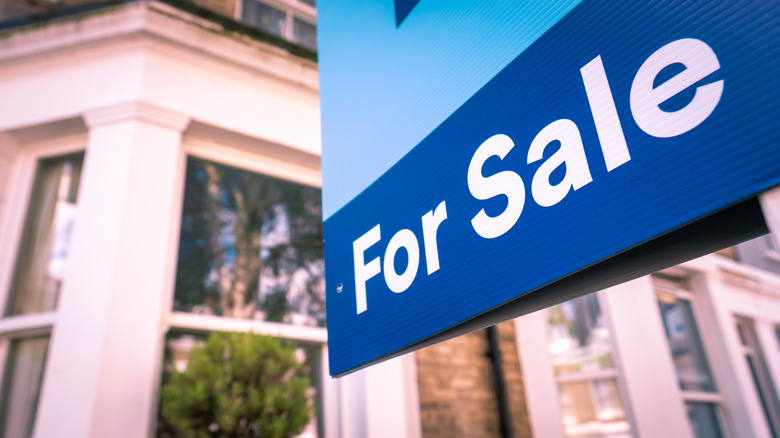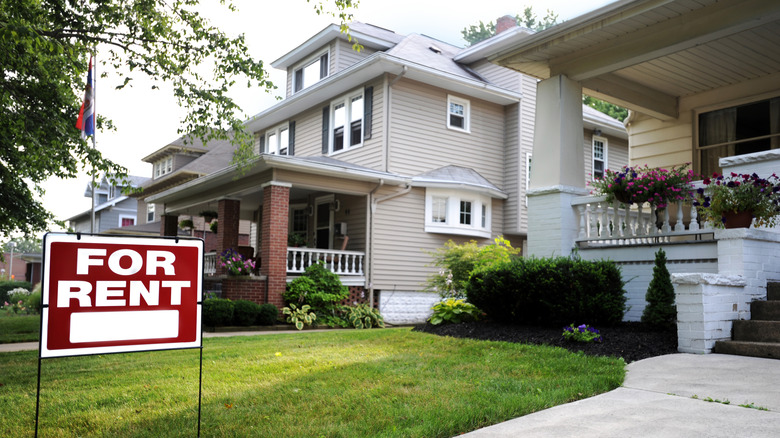10 Top Signs The Housing Market Is About To Crash
Ebb and flow is an apt description for housing markets all over the world. Home value appreciates at a fairly standard 5.3% annually (from 1992 to 2022, according to CEIC Data). But, homeowners can't fundamentally bank on non-stop growth in the real estate market and a guaranteed level of value at any given point in time. Housing markets see price fluctuation on a near-daily basis. However, market acceleration and crashes can happen at any moment.
The first thing that should be noted when discussing real estate market momentum is that a vast array of data points and trends can signal stress on the market, both locally and on a broader, national level. Individually, they can precede hiccups in the marketplace and signal potential trouble for sellers who may be thinking of moving in the coming months or years. Looking at these indicators is akin to conducting market research when approaching the stock market or any other type of investment. Homeowners should always keep general tabs on the property market and overall economic stability.
Once again, real estate market trends see tremendous movement on a routine basis. This means that your home may be worth more today than it was yesterday, but less in three weeks from now. These are normal price fluctuations and are influenced by a wide variety of factors, some of which you can control, and others that remain beyond your influence. For one thing, the sale prices of other properties in your area can impact the value that your home would be assessed at on any given day. Simply put, taken individually, these 10 signs are important to understand and can showcase stressors that hint toward a real estate market downturn looming just around the corner.
Broad economic pressure places homeowners in riskier positions
On a macro level, external pressures that have nothing to do with real estate can influence real estate pricing models at the local level. For instance, homeowners everywhere are dealing with the fallout from a global pandemic that saw many jobs and roles evolve dramatically, and other jobs simply evaporate (World Economic Forum reports that 114 million jobs were lost globally in 2020 alone). This has changed the way that consumers budget, save, and plan for their future in many meaningful and nuanced ways. Fiscal uncertainty and vulnerability in the workplace can lead to unique budgeting measures. One potential consequence of this change is an increase in mortgage defaults as homeowners struggle to keep up with their bills. Economic uncertainty can place the average homeowner under increased stress and ramp up the risk of financial consequences.
On another note, the war in Ukraine has led to an ongoing energy crisis in Europe. Market pressures influence different segments in fascinating and often unpredictable ways. Coupled with supply chain trouble that has plagued the world since the early days of the COVID-19 pandemic, this energy crisis has sent inflation in Europe and the United States skyrocketing. Ballooned inflation leads to higher interest rates on all borrowed capital as governments try to fend off the depreciation of currency value. The result for homeowners is an increase in total dollars owed each month on all kinds of different loan products, leading to the same vulnerability that can put homeowners at risk.
The first direct sign is a plateau in home pricing
Whether through macroeconomic trends or simply out of necessity from an overheated market, the first direct sign that a price crash may be looming is a plateau of pricing after a long bull run in the real estate space. In any marketplace, a sustained plateau in pricing is the first obvious sign that market prices have become stagnant through the establishment of a pricing ceiling. Once again, it should be noted that this phenomenon alone does not indicate a turn toward cratering prices in the housing market. However, pricing stagnation is a point of concern for homeowners looking to sell their property in the near future and anyone looking out for indicators of a potential crash.
Even as this change in fundamental value growth may signal future trouble, it's certainly possible that pricing stagnation is simply a sign that the market is experiencing a mean reversion. Instead of dramatically plummeting prices, a mean reversion is a retraction that brings prices back toward an average level. Scientifically, an average is just that: A midpoint figure between the high and low extremities. As sellers continue to list their homes and close on new deals with buyers, their experiences in the market will be their own, and yet these sales prices factor into ongoing average market data. If the market has become too hot, it's possible that a mean reversion can take place where buyers regain leverage and prices are driven temporarily lower.
An increasing number of homes for sale
One aspect of a mean reversion or market crash is a plethora of homes listed for sale at any given time. Market data includes information about all manner of statistics. One important feature of any property listing is the number of days it's been on the market. When days on the market (DOM) begins to increase for the average seller, there will naturally be an increase in the number of listings available for buyers to peruse. An increase in the volume of available homes shifts strength to buyers. High DOM figures are typically an indicator that something may be amiss with a particular property. But when these numbers rise across a market more broadly, it hints at a more systemic kind of weakness.
In a buyers' market, sellers are less able to dictate the price and other features of an agreement to transfer property. When sellers maintain control, they often enjoy the benefits of a bidding war, the ability to pass on costs to the buyer, and faster selling timelines. This puts pressure on buyers to make rapid decisions when it comes to purchasing any home listing.
In a buyers' market, sellers can see a decrease in the value of their property, as buyers have much more supply to choose from. These trends shift back and forth on a regular basis, but a sustained buyers' market can lead to increasingly depressed prices. Over time this can lead to the potential for a crash.
Absorption rates in your area begin to decrease
The absorption rate signifies the opposite end of the inventory and days on the market equation. Absorption rates indicate how quickly buyers are purchasing properties in the real estate market. A high absorption rate indicates a strong and thriving marketplace that is experiencing typical upward momentum. Alternatively, low absorption rates mean that buyers aren't buying properties for one reason or another and can signal a shift toward corrective or reversion periods, and even the establishment of a bear marketplace.
Absorption rates can drop for a variety of reasons from declining school quality to lack of area job growth. But a market that sees both low absorption rates and high inventory is likely one that is facing imminent difficulties. These two figures, when combined, signify a major disconnect between buyers and sellers and an economic environment that isn't particularly friendly or conducive to the fiscal realities of homeownership.
Foreclosure rates increase
Another key figure to keep in mind when evaluating the strength of the marketplace is foreclosure rates. In the same way that an increasing number of homes for sale coupled with low purchasing figures can signal trouble looming on the horizon, foreclosures provide a window into a more sinister future. If foreclosures are rising, this means that more and more homeowners have become unable to keep up with their financial responsibilities.
Generally speaking, a homeowner who is going into foreclosure is one that has many other fiscal problems on top of their trouble paying the mortgage. Rarely does foreclosure happen simply because a homeowner decides not to pay their bill. The loss of a job, surprise medical expenses, and other major changes that may be sudden or even occur over the long term are often an outsized part of the equation.
A homeowner might opt to sell their property before it goes into foreclosure, leading to increased availability on the market. But when the real estate space is trending south, it may be difficult for a homeowner to actually move the asset, ultimately resulting in a higher number of foreclosures. This can suggest a tipping point at the outer extreme of these previous signs that something is souring in the real estate space.
Average wage-to-capital value comparisons begin to skew long
Wage to capital value is an important figure when considering the suitability of a prospective home buyer. What this ratio suggests is how many years it would take a person to pay off a property without considering any other financial obligations.
This is solely a calculation of income versus the current market price of a real estate asset. Typically, a healthy wage-to-capital ratio sits between 5 and 10, meaning it would take the average buyer between 5 and 10 years to purchase the average property in any given area. Lower figures suggest increased wage earning power, whereas a higher number suggests that wages are flagging behind the inflation rate and average home price. For context, the St. Louis Federal Reserve reports that the average home in the third quarter of 2022 cost $542,900; this means a ratio figure of 7.5 (splitting the difference) would require a salary of around $72,386 per year ($542,900 / 7.5). The Bureau of Labor Statistics reports that the average salary as of May 2021 was $58,260.
This is a useful indicator because it establishes a window into the relationship between ongoing economic stability and the real estate market more specifically. High wages, low to moderate prices, and a strong economy combine to give buyers a high level of confidence in their ability to repay debts and purchase a home. On the other end of the spectrum, high prices coupled with economic uncertainty lead buyers and lenders to a natural state of hesitancy when it comes to making any new purchase in the real estate space. This leads to higher mortgage rates and fewer buyers overall which ultimately deflates the real estate market.
Rental pricing versus capital values have trended away from one another
Tim Thomas notes that a comparison between rental pricing and the capital value of properties is one of the most valuable metrics that a person can use to judge the health of the real estate market. In a healthy marketplace, rental prices and home value move in relation to or even in lockstep with one another. As market conditions increasingly become favorable, rental prices go up along with the value of the asset itself. However, a market bubble can occur when rental prices remain static and home prices continue to rise unimpeded. A divergent value in assessed pricing and typical rental price structure is a sign that the market is experiencing an unhealthy evolution and may be headed for a cliff.
Rental prices move in their own unique way. But strictly speaking, in a healthy marketplace rental figures will continue to inflate along with other common goods and services. As wages increase and the cost of goods rise, rent is simply something that moves with the market. But, in times of economic crisis rental costs may not move in a meaningful way. This is because renters as a unit are constantly seeking new properties that fit their needs. But in times of economic stress, they may be unwilling to pay increasingly inflated prices. This leads to less movement among renters, and a diminished ability to charge higher prices by landlords. A sickly rental market coupled with continually increasing market values on homes is a dramatic signifier when it comes to evaluating overall health in the real estate space.
A jump in interest rates on mortgages
The classic example of an unhealthy real estate market is a sudden jump in interest rates. This goes for other borrowing products too, but it's a surefire sign that the market is souring when buyers are facing dramatically inflated mortgage costs.
Rising interest rates signal a weakening position for buyers. One of the main draws for a home buyer is the ability to purchase a property at a minuscule interest rate. This gulf between mortgage rates and other personal loan or credit card products is essential considering the vastly larger amount of capital that a mortgage involves. Higher interest rates make affordability far less common. If fewer buyers are able to afford to purchase a home, this leads to a reduction in sales, rising days on the market figures, and many other signals that have already been listed. As a result, it's common to see more than one signifier of bear market trends occurring at the same time. Concurrently, increased stock and other signals can ultimately result in rising interest rates, turning this relationship around in the other direction.
Riskier mortgage approvals become commonplace
As a result of other features that may present themselves during bear market conditions, mortgage lenders may become less stringent in their eligibility practices and application procedures. The housing crisis that set off tumbling markets in 2007 was spurred on by an enormous increase in subprime mortgage lending practices. While regulations have been put in place to prevent the same kind of market calamity that happened 15 years ago, subprime lending in various forms remains a common practice in the mortgage industry today.
Looking to an uptick in risky lending practices can signal negative pressure on the market. What should always be remembered is that mortgage lenders are in the business of providing funds to buyers. The more mortgages they fund, the more money they make. As buyers evaporate from the marketplace, lenders are incentivized to let their standards lapse to continue funding new mortgages and keep their profits on track. Another fundamental truth of the industry is that lenders enjoy insurance coverage for their capital. This means that even if you don't pay and the home is foreclosed on, a lender will be made whole. In large part, what led to the collapse of the 2000s was the sheer volume of foreclosures resulting from this shift. Mortgage lenders had overextended the number of these risky lending products and the bill came due as a tidal wave rather than a slow trickle.
Buyer sentiment takes on a tangible negativity
Lastly, it's important to understand the value of buyer and seller sentiment. Attitudes can go a long way to influencing the overall health of any type of asset marketplace. If buyers are experiencing and talking about a noticeable squeeze when it comes to scouring the market for properties that meet their needs that it may be safe to assume that the market is headed for a slowdown. Of course, market sentiment isn't everything and often times attitudes can only signal short and intermediate-term changes in pricing structure.
Conversation powers reality in many instances, and the same can be said for the real estate market. As a result, it can be worthwhile to discuss the market as a whole with real estate professionals. Realtors spend their days viewing properties, talking with buyers and sellers, and thinking about the market and the variety of possible short-term futures. This means they are uniquely positioned to provide insight into the way people are thinking about real estate at any given time. Speculation can be a powerful tool, but it remains just that. Taking any information you glean through word of mouth with a grain of salt is always the best way to evaluate this signal of potential for the market. But taken in coordination with many or all of these other structural changes, the speculators may be on to something.










